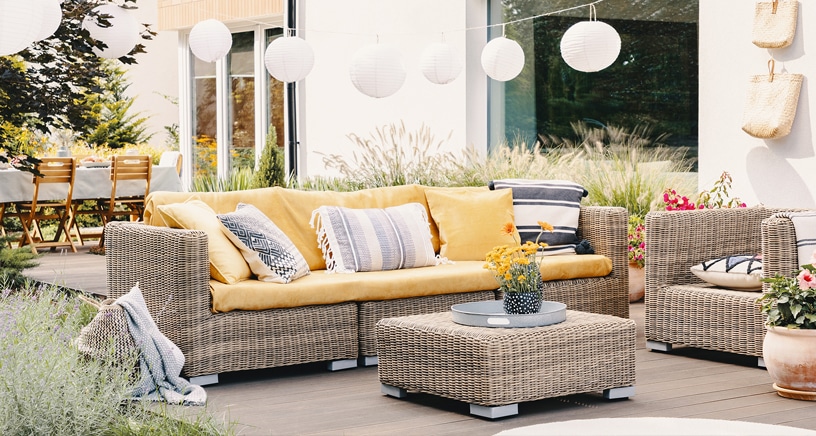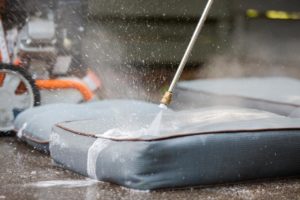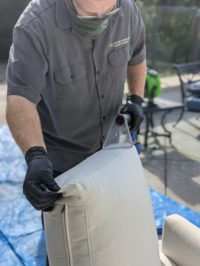We’re officially calling it: it’s time to mow the lawn, assemble the deck chairs, and get your patio cushions out.
But before you can enjoy the sunshine, it’s important to make sure your yard is set up for the season – and that means getting to grips with outdoor cushion cleaning and choosing patio furniture that’s right for your lifestyle.
Here, we’ll talk your through some of the most popular types of outdoor furniture and explain how to care for and clean the cushions that you place on top.

What patio furniture material is the best?
While style and price are top of mind when choosing patio furniture, it’s important to pause for a moment and think about the most important factor: durability.
You’re basically buying a bunch of tables, chairs, and sofas that have to sit outside and withstand months of sun, wind, and (hopefully not too much) rain. That means you need something that won’t rust, corrode, fade, or get moldy.
Of course, you also want to find furniture that suits the aesthetic of your home and is comfortable to sit on – luckily, there are plenty of options that cover all these bases.
Wood: Sturdy and classic, wood is a timeless choice. Be sure to choose hardwood (like teak) to avoid water damage. You should also treat wooden patio furniture with a sealant every year, to maintain its quality for next season.
Stainless steel: Durable and strong, stainless steel is a solid all-weather investment. Bear in mind that it’s heavy and difficult to maneuver, so a better choice for a more permanent set-up.
Aluminum: A great budget-friendly option, which is water resistant and won’t rust in the rain. It’s easy to find a variety of aluminum patio furniture styles to suit your taste, and the lightweight design makes it easy to handle. Just be wary placing it in high-wind areas.
Iron: Another strong and durable metal choice, iron is susceptible to rusting, so be sure to protect it during wet weather. Available in many impressive, timeless designs, it’s a heavy choice that’s best suited to a permanent layout.
Plastic: Synthetic plastic patio furniture is incredibly versatile and durable, as it won’t rust or get moldy. Available in pretty much any style you can imagine, it’s also easy to move around to suit your mood. Be wary of placing ultra-lightweight plastic furniture in windy spots. Lower-quality plastic furniture may also crack or break easily, so opt for a mid to high-quality option when possible.
Outdoor cushion care tips
 Choosing your furniture pieces is only the beginning – what really makes your outdoor hours special is the comfy cushions you place on top.
Choosing your furniture pieces is only the beginning – what really makes your outdoor hours special is the comfy cushions you place on top.
Most outdoor cushions are made from synthetic fibers, which can better handle the outdoor climate and resist fading. But that doesn’t mean they’re invincible – it’s important to make outdoor cushion cleaning a regular part of your routine, to protect your investment over the long run.
How to wash outside cushions (with stain removal tips)
Outdoor cushions are fairly easy to keep clean, because they’re typically made from synthetic fibers. During the season, you can wipe them down every few days to fight off daily mess.
The best way to clean outdoor furniture cushions
- Use a brush to get rid of any loose dirt and dust.
- Wipe the covers down using hot water and a damp cloth or brush – avoid off-the-shelf cleaning products and harsh chemicals, as these can damage the quality of the cushion covers.
- Be careful not to oversaturate your outdoor cushions – just use a little bit of water at a time.
- Allow them to dry completely in the sun.
How to treat stains on outdoor cushions
On those inevitable occasions where stray barbecue sauce or red wine splashes onto your cushions, treat the stain immediately:
- Blot the area with a clean, white cloth to remove as much of the substance as possible.
- Pour a little bit of warm water around the stain (not directly on it)
- Dab the soiled area with another clean white cloth to remove the stain.
- Repeat until the stain is gone.
In the event of a stain 911, it’s always best to reach out to the pros – our experts will know exactly what products and methods to use on your cushions to avoid further damage or discoloration.
How often you should clean outdoor cushions
Give your cushions a routine wipe-down every two weeks (or more frequently, if your backyard is particularly busy during the good-weather season). Do not take the covers off to wash them, as you will never be able to put them back on properly, and the internal cushions will cause wrinkling and bumps.
At least once a year, you should get your outdoor cushions cleaned at a facility where professionals can use high-powered equipment and hot water extraction methods to comprehensively saturate and dry your cushions.
As well as making sure they’re in top shape for next season, this will prevent mold and mildew from infiltrating the filling.
How to weatherproof outdoor cushions
 When it’s time to put your cushions away at the end of the season, make sure they’re securely wrapped in a water-proof and pest-resistant casing. There’s nothing worse than getting your yard set up and discovering that your cushions have gone moldy – or become a luxury winter-long retreat for mice or raccoons.
When it’s time to put your cushions away at the end of the season, make sure they’re securely wrapped in a water-proof and pest-resistant casing. There’s nothing worse than getting your yard set up and discovering that your cushions have gone moldy – or become a luxury winter-long retreat for mice or raccoons.
Hardware stores offer many DIY solutions, including packing sheets and rolls – if you go down this route, be sure to secure your cushions from all angles and avoid air pockets. If you get your cushions professionally cleaned at the end of the season, we can even store them for you if you wish!
Patio furniture and cushions are key to enjoying the warmer months. By choosing the right materials and caring for your outdoor cushions properly, you can make the most of your investment and create a backyard setting that’s comfortable and carefree all day long.
Learn more about our outdoor cushion cleaning service or get in touch for to talk to our expert about a customized quote.
Request a Quote
We’ll be in contact with you shortly to give you an estimate.
